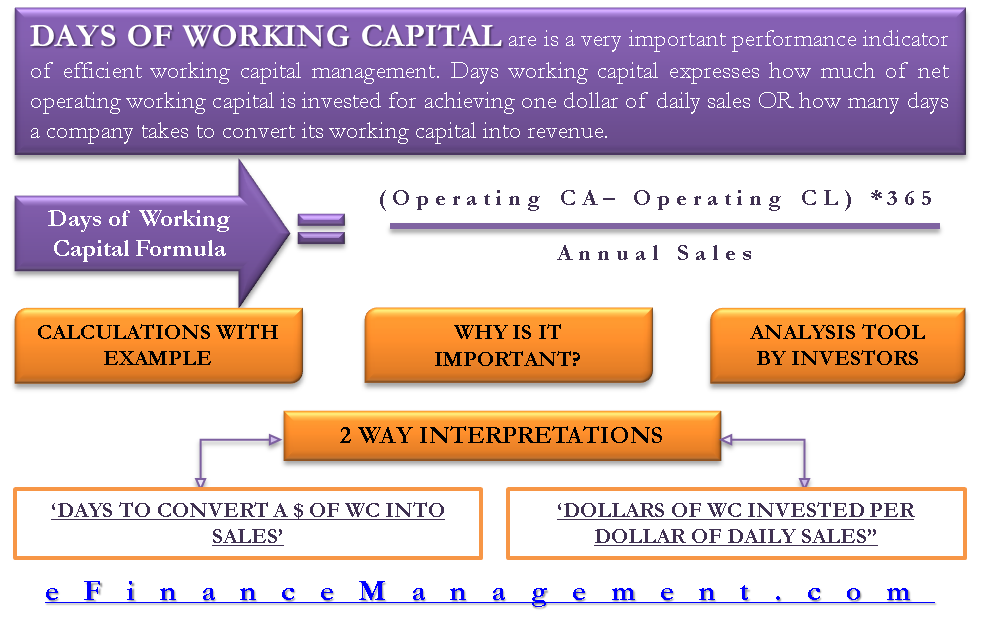What is Days Working Capital (DWC)?
Days working capital is a very important performance indicator of efficient working capital management. The lower the working capital days, the better the efficiency of working capital management and vice versa. What exactly does it express? Days of working capital express how much net operating working capital is invested for achieving one dollar of daily sales. From the opposite angle, we can also express how many days a company takes to convert its working capital into revenue. Let’s try to understand it in detail.
Days of Working Capital Formula
Let us see and understand the formula for expressing the days of working capital as below:
| Days of Working Capital = [(Operating Current Assets – Operating Current Liabilities) / Annual Sales] * 365 |
OR
Days of Working Capital = Net Working Capital / Average Daily Sales
Or
Days Working Capital = 1 / Working Capital Turnover
Here,
Operating Current Assets |
Operating Current Liabilities |
| It includes: | It includes: |
| Accounts receivable | Accounts payable |
| Inventory | Notes payable |
| Cash and marketable securities | Other short-term liabilities (within 1 year) |
| Other short-term assets (within 1 year) |
Why is the term operating used with the Current Assets? It is because we will not include non-operating current assets that do not contribute directly to the company’s core operations like extra funds kept in expectation of an acquisition opportunity, funds reserved for payment in case the company loses a lawsuit, etc.

Days of Working Capital Calculation and Example
Now, let’s understand how to calculate working capital days with an example.
Take balance sheet excerpts of ABC Ltd, which has annual revenue of $37,500,000.
| Current Assets | Amount (in $) | Current Liabilities | Amount (in $) |
| Cash | $90,000 | Accounts Payable | $45,000 |
| Marketable Securities | $15,000 | Accrued Expenses | $30,000 |
| Accounts Receivable | $60,000 | Notes Payable | $7,500 |
| Inventories | $75,000 | ||
| Total Current Assets | $240,000 | Total Current Liabilities | $82,500 |
Net Operating Working Capital = $240,000 – $82,500 = $157,500
Average Daily Sales = 37,500,000/365 = 102,740
Therefore,
Days Working Capital = Net Operating Working Capital / Average Daily Sales
Days Working Capital = 157,500 / 102,740 = 1.53
Interpretation of Days Working Capital
Now we see that result of DWC in the above example is 1.53. We can interpret or analyze the figure in two ways – ‘Days to Convert a $ of WC into Sales’ and ‘Dollars of WC invested per Dollar of Daily Sales.’
‘Days to Convert a $ of WC into Sales’
We can consider 1.53 as 1.53 days ABC company takes to convert the investment in working capital into sales. As per the example, by investing an amount of $157,500 in a day, the company is achieving sales of $102,740. Note that the sales are less than the investment made. In other words, the company takes 1.53 days to achieve a sales value equal to $157,500, i.e., investment in working capital.
Also Read: Working Capital
The idea for a company should be to minimize this figure to as less as possible. Assume with a lot of hard work on achieving working capital efficiencies, the company reaches a DWC of 1. This would mean with the same amount of investment in working capital, i.e., $157,500, the company’s per day sales would be $157,500. What have we achieved by doing this? We have achieved more sales with the same working capital. Keeping other things constant for the time being it will lead to more EBIT due to an increase in sales, but the interest cost will remain the same. So, the EBT will improve due to savings on interest costs.
‘Dollars of WC invested per Dollar of Daily Sales.”
In the same fashion, if we consider 1.53 dollars of WC is invested for achieving a dollar of sales. For improved efficiencies in working capital management, there are 3 ways:
- Increase sales without an increase in working capital
- Reduce working capital without reducing Sales
- Do Both
By targeting the above, the DWC of 1.53 will, say, reduce to 1 dollar. This means that for getting sales of 1 dollar, we are investing only 1 dollar in working capital which was 1.53 dollars earlier. The same effect on EBT will be there, as we explained above.
How to take Actionable Steps by Analyzing Days Working Capital?
We can express the Days of Working Capital like the following as well. It is because, ultimately, in this ratio, we are only comparing the short-term current assets and liabilities with sales of the company.
| Days Sales Outstanding | 0.58 | Days Accounts Payable Outstanding | 0.44 |
| Days Inventory Outstanding | 0.73 | Days Short Term Liabilities Outstanding | 0.37 |
| Days Cash and Marketable Security Outstanding | 1.02 | ||
| Days Current Assets Outstanding (A) | 2.34 | Days Current Liabilities Outstanding (B) | 0.80 |
DWC = Days Current Assets Outstanding – Days Current Liabilities Outstanding
=> DWC = Days Sales Outstanding + Days Inventory Outstanding + Days Cash and Equivalents Outstanding – Days Accounts Payable Outstanding – Days Short Term Liabilities Outstanding
=> DWC = 0.58 + 0.73 + 1.02 – 0.44 – 0.37 = 1.53
With this representation, the objective becomes clearer for the management. We need to reduce the side of current assets and increase the side of current liabilities to improve the overall DWC.
We can see that a lot of money is stuck in cash and marketable securities (1.02 contributed to DWC with an amount of $105,000). The finance manager can always prioritize this area and analyze if the amount of cash and marketable securities can reduce without negatively impacting the smooth working capital cycle.
Importance of Days of Working Capital
Look at the following images (excerpts from the book Financial Management, Theory and Practice, 13e, by Brigham and Ehrhardt.) It states about DWC of US companies. We can see that the DWC of companies varies from 51 days to -154 days.

With these wide variations in DWC, you may dedicate yourself to the different operating environments of different industries. But there are huge variations within industries also. Just see below:

This is why we say that this metric is very important, and the company’s management should work on improving the same. There are techniques like Just in Time, EOQ, etc., which can be followed and implemented, and you can notice an improvement in DWC.
Analysis with Days of Working Capital
Investors use this ratio of days of working capital to analyze or make a comparison between different companies in the same sector. It should be noted that the DWC, as seen in the example, would differ with industries. DWC will make sense only if analyzed and compared with players within the same industry. It is a part of fundamental analysis also.

